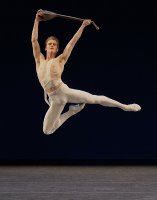By Rachel Straus
May 1-2
Guggenheim Museum
The popular Works + Process series presents “American Ballet Theatre on to Act II.” Current ABT dancers will perform excerpts from their upcoming Metropolitan Opera House season. ABT alumni will discuss the challenges dancers face in the second act of their careers. You can watch the event each night at 7:30 via livestream.
May 2
Baryshnikov Arts Center
In the final spring installment of BAC Flicks: Mondays With Merce, two Charles Atlas films of Merce Cunningham’s dances will be projected on widescreen. In “Crises” (1960), elastic cords connect the dancers to each other. Dramatic entanglements ensue. In “Native Green” (1985), John King’s music and William Anastasi’s evoke a scintillating spring. Cunningham scholar Nancy Dalva will speak to former Cunningham dancer Gus Solomons, Jr.
May 3-June 12
The David H. Koch Theater
The opening week of the New York City Ballet’s spring season will showcase 12 of Balanchine’s works, which insiders refer to as “black and white” ballets because the costuming is bare bones. Most often, the women wear black leotards and white tights. The men wear black tights and white t-shirts. The choreography is hardly sparse. Up next will be the May 11 world premiere of Lynne Taylor-Corbett’s “The Seven Deadly Sins,” set to the Kurt Weill score, featuring Patti LuPone and Wendy Whelan as sisters (which will be hard to believe). The final week’s performances are titled “See the Music…” and will highlight NYCB’s musical repertory as performed by its 62-piece orchestra. The June 12 “Dancer’s Choice” performance will feature works handpicked by the company’s dancers. Over the seven-week season, the company will perform 19 works by Jerome Robbins, Susan Stroman, Christopher Wheeldon, NYCB Ballet Master in Chief Peter Martins, and George Balanchine.
May 3
The Apollo Theater
This Alvin Ailey American Dance Theater benefit performance will showcase Camille A. Brown’s 2007 solo “Evolution of a Secured Feminine,” which catapulted this complex, hip, young choreographer into the spotlight.
May 10-22
The Joyce Theater
The two-week engagement of Cuba’s Danza Contemporanea de Cuba stands out for its offering of three works: The U.S. premiere of “Casi-Casa,” created by the quirky, inventive Swedish choreographer Mats Ek, set to disco, hip-hop, swing and jazz; the world premiere of “Horizonte” by former Ballet Hispanico dancer Pedro Ruiz; and “Demo-N/Crazy,” made by Sydney Dance Company artistic director Rafael Bonachela, which has been said to wow for its athletic partnering and semi nudity.
May 12-14
Cedar Lake Theater
Cedar Lake Contemporary Ballet will present a new installation created by artistic director Benoit-Swan Pouffer. Part choreographed dance performance and part interactive installation, audience members are invited to move freely through the space where the dancers will be performing.
May 12-15
Dicapo Opera Theatre
Dances Patrelle will present the world premiere of Francis Patrelle’s “Gilbert & Sullivan, The Ballet!” an evening-length work, featuring live music and singers, and inspired by characters drawn from Gilbert and Sullivan’s comic operas.
May 13
Buttenwieser Hall at 92nd St. Y
The “Fridays at Noon” free series will culminate with informal performances by tap and step dancing virtuosos Marshall Davis, Jr., Andrew Nemr, and their guests. Davis, Jr. performed in Savion Glover’s Tony Award winning “Bring in ‘Da Noise Bring in ‘Da Funk.” Nemr has the credentials too, having performed along side the Duke Ellington Orchestra, Jimmy Heath, Les Paul, Harry Connick and the Lionel Hampton Orchestra.
May 16-June 29
Metropolitan Opera House
American Ballet Theatre will hold its annual seven-week season. The big event will be the New York premiere (June 9) of Alexei Ratmansky’s “Bright Stream.” Also of interest will be two world premieres (May 24-26) by Ratmansky and Christopher Wheeldon, a New York premiere by Benjamin Millepied, and a revival of Antony Tudor’s “Shadowplay.” The full-length ballet offerings will be “Giselle,” “Swan Lake,” “Cinderella,” “Coppelia,” “Don Quixote,” “The Sleeping Beauty,” and “Lady of the Camellias.”
May 20
Ailey Citigroup Theater
“Performing the Border” aspires to blend and build on the grammar of two Indian classical dance forms, Bharata Natyam and Odissi. David Phoenix Singh, who runs Dakshina Company, a Bharata Natyam and modern dance company, and Nandini Sikand, who directs Sakshi Productions, a neo-classical and contemporary Odissi dance company, will collaborate.
May 21
Manhattan streets
This year’s New York City Dance Parade will showcase 65 dance genres. The parade will start on 21st street, move down Broadway, pass through Union Square, and take over University Place, Eighth Street and St. Mark’s. The House, Techno and Disco floats will lead the celebrants to Tompkins Square Park and to DanceFest, which will offer stage and site specific dance performances and free dance lessons. This will not be a sedentary experience.
May 23
Judson Memorial Church
This year’s Movement Research Gala will feature Trisha Brown’s “Set and Reset” (1983) as performed by its original cast of dancers, who have become dance makers in their own right.

